 So, your doctor recommends you attend physical therapy. If you’ve never had physical therapy, you probably have lots of questions. Don’t worry! We’ll answer some of your frequently asked questions about physical therapy in the following post.
So, your doctor recommends you attend physical therapy. If you’ve never had physical therapy, you probably have lots of questions. Don’t worry! We’ll answer some of your frequently asked questions about physical therapy in the following post.
What is physical therapy (PT)?
Merriam-Webster.com defines PT as, “therapy for the preservation, enhancement, or restoration of movement and physical function impaired or threatened by disease, injury, or disability that utilizes therapeutic exercise, physical modalities (such as massage and electrotherapy), assistive devices, and patient education and training.” Furthermore, physical therapy is a conservative (nonsurgical) treatment option that helps patients restore range of motion and muscular strength in order to relieve pain, prepare for surgery, or restore the body after surgery.
What is a physical therapist?
Physical therapists are highly trained experts. In fact, in order to become a physical therapist, individuals must complete an undergraduate degree followed by a doctorate degree in physical therapy (DPT). Through their education and training, therapists become movement specialists who help patients who have medical problems or injuries that limit their movement and function to improve their quality of life. Often, these professionals help patients through hands-on treatments, as well as education.
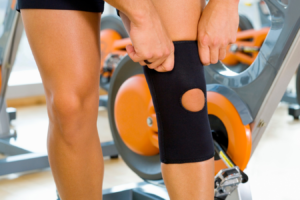 What is PT used to treat?
What is PT used to treat?
PT can be used to treat a multitude of conditions and illnesses. It can also be used in a variety of situations. Our onsite physical therapy program AOS specializes in building strength, improving mobility, and enhancing function. Here are some of the situations in which we use physical therapy:
- Post-surgery
- Joint replacement, pre-and-post surgery
- Low back pain, lumbar radiculopathy, herniated disc, and sciatica
- Cervical pain, cervical radiculopathy, thoracic outlet, and herniated disc
- Shoulder impingement, AC joint sprain, rotator cuff tear, labral tear, and general shoulder pain
- Epicondylitis of the elbow, UCL reconstruction, cubital tunnel syndrome, and bicep/tricep pain
- Hip bursitis, ITB syndrome, hip fracture care, piriformis syndrome, and SI dysfunction
- Knee pain, patella-femoral pain, meniscal injuries, tendonitis, and dislocation
- Foot and ankle pain, Achilles tendonitis, plantar fasciitis, fracture management, acute ankle sprain, and instability
- Hand and wrist pain, carpal tunnel syndrome, thumb sprain, and bracing/splinting of the wrist, hand, and finger
- Return to the gym, exercise, and sports regimen
What happens during physical therapy?
During your first visit, the physical therapist will discuss your specific circumstance with you. Then, they will create a plan tailored to your individual needs to help you heal and strengthen your body. The American Physical Therapy Association states that PT sessions have three parts:
- Assessment and examination. During this part of your session, you will be asked to answer a number of questions like, “where are you feeling pain?” Additionally, you will be asked to perform a variety of physical movements depending on the answers to their questions.
- Diagnosis. Then, the physical therapist will determine a diagnosis, often working with your doctor as part of your health care team to set goals for your PT sessions.
- Treatment plan implementation. PT treatment plans may include any number of activities during your session. For example, your physical therapist may use therapeutic modalities such as heat, ice, or electrical stimulation. Additionally, your PT session may include massage and mobilization treatments, as well as exercises to increase strength, mobility, and function.
Your physical therapist will lead you through this entire process.
 Why is physical therapy so important?
Why is physical therapy so important?
Typically, physical therapy is the first step when a patient experiences joint or muscle pain. Physical therapy often helps patients avoid surgery altogether. But PT can also help patients prepare for surgery to avoid complications during and after the procedure. Additionally, it can also aid patients in regaining strength, mobility, and function after surgery.
But how is PT so effective? Essentially, most of the therapies performed during PT promote blood circulation in the body. Blood circulation carries white blood cells, nutrients, and oxygen to inflammation in the body. Ultimately, this accelerates and enhances the healing and recovery process.
Physical therapy can also be educational. Some patients attend physical therapy and learn they’ve been performing a certain movement wrong which resulted in an injury. For example, someone twists too much when they run, which resulted in back pain. Physical therapists can help bring the issue to light and educate and instruct the patient on how to correct their movements and ultimately, improve pain.
 What’s the difference between physical therapy and occupational therapy?
What’s the difference between physical therapy and occupational therapy?
By now, you’ve learned PT helps patients manage pain, increase mobility, improve muscle strength, and much more. However, occupational therapy is geared more toward helping patients improve their daily skills. It could be used following surgery or due to a birth defect, behavioral health problems, or anything that may affect a person’s ability to go about daily life and work. For example, if someone has carpal tunnel surgery or breaks their hand, they may need help learning proper hand function again. An occupational therapist might help them improve their fine motor skills and assist them in re-learning how to do things like getting dressed or writing.
When should I talk to a doctor?
Remember, any condition may worsen and lead to additional complications if left untreated. If you notice your symptoms negatively impact your life, consult a specialist as soon as possible. This will help to ensure you receive a proper diagnosis and treatment plan, which will likely include physical therapy.
AOS can help.
At AOS, we believe PT is a crucial step in every patient’s recovery – surgical and non-surgical. Additionally, we believe a team approach to care leads to better outcomes. That’s why we share each patient’s physical or occupational therapy visit with the doctor who recommended it. So, the physician and/or specialist and physical therapist are always in contact with each other, adjusting treatment as needed.
At Advanced Ortho and Spine (AOS), our physicians work closely with our physical therapists to ensure the best care possible for our patients. Each of our physicians, including Dr. Christopher Cook, Dr. James Eby, Dr. Tarek Elalayli, Dr. Michael LaDouceur, Dr. Erik Maryniw, Dr. Roger Passmore, Dr. Mitul Patel, and Dr. Lee Swiderek specialize in a variety of orthopaedic treatments and procedures. We always focus on conservative, minimally invasive treatment first before surgery is considered.
Request an appointment online or call us at 615.885.0200 to schedule yours today.
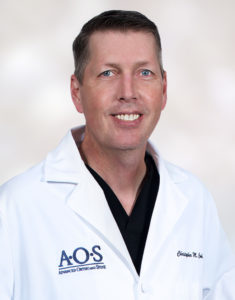 Dr. Christopher Cook is a Board-Certified Orthopaedic Surgeon and Sports Medicine & Joint Replacement Specialist at Advanced Ortho and Spine. He provides a full spectrum of Joint Replacement, Sports Medicine, and Shoulder & Upper Extremity services. Contact us today for more information or to request an appointment. Contact us today for more information or to request an appointment.
Dr. Christopher Cook is a Board-Certified Orthopaedic Surgeon and Sports Medicine & Joint Replacement Specialist at Advanced Ortho and Spine. He provides a full spectrum of Joint Replacement, Sports Medicine, and Shoulder & Upper Extremity services. Contact us today for more information or to request an appointment. Contact us today for more information or to request an appointment.
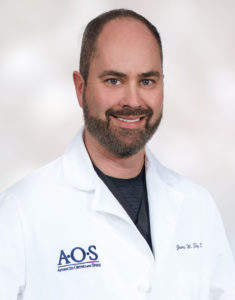
James Eby, MD, is a board-certified physiatrist, who specializes in nonoperative spinal procedures at Advanced Ortho & Spine. He provides a full spectrum of Physical Medicine treatments. Contact us today for more information or to request an appointment.
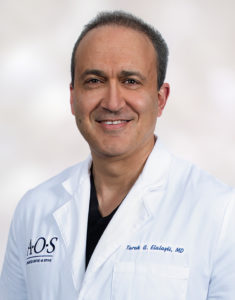 Dr. Tarek Elalayli is a board-certified orthopaedic spine surgeon, who specializes in treating a full range of spinal conditions. Contact us today for more information or to request an appointment.
Dr. Tarek Elalayli is a board-certified orthopaedic spine surgeon, who specializes in treating a full range of spinal conditions. Contact us today for more information or to request an appointment.
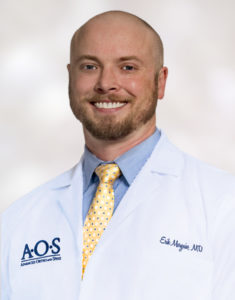 Dr. Erik Maryniw is a Board-Certified Hand and Upper Extremity Orthopaedic Surgeon at Advanced Ortho and Spine. He provides a full spectrum of Orthopaedic care and Microvascular Surgery from the hand to the shoulder. Contact us today for more information or to request an appointment.
Dr. Erik Maryniw is a Board-Certified Hand and Upper Extremity Orthopaedic Surgeon at Advanced Ortho and Spine. He provides a full spectrum of Orthopaedic care and Microvascular Surgery from the hand to the shoulder. Contact us today for more information or to request an appointment.
 Mitul Patel, MD is a board-certified orthopaedic spine surgeon, who specializes in treating a full range of spinal conditions. Contact us today for more information or to request an appointment.
Mitul Patel, MD is a board-certified orthopaedic spine surgeon, who specializes in treating a full range of spinal conditions. Contact us today for more information or to request an appointment.
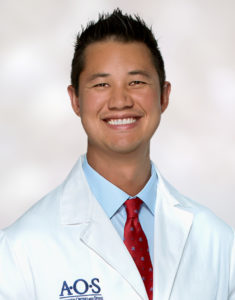 Dr. Lee Swiderek is a Fellowship-Trained Orthopedic Surgeon & Joint Replacement Specialist at Advanced Ortho and Spine. He provides a full spectrum of Joint Replacement and Complex Hip and Knee Reconstruction services. Contact us today for more information or to request an appointment.
Dr. Lee Swiderek is a Fellowship-Trained Orthopedic Surgeon & Joint Replacement Specialist at Advanced Ortho and Spine. He provides a full spectrum of Joint Replacement and Complex Hip and Knee Reconstruction services. Contact us today for more information or to request an appointment.
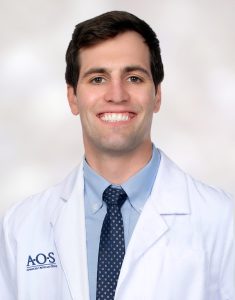 Dr. Daniel Hagaman is a Fellowship-Trained Orthopaedic Surgeon & Sports Medicine Specialist at Advanced Ortho and Spine. He specializes in a range of orthopaedic conditions and treatments including Knee Arthroscopy, Knee Ligament & Cartilage Repair, Shoulder Arthroscopy, Hip Arthroscopy, Orthobiologistics, and more. Contact us today for more information and to request an appointment.
Dr. Daniel Hagaman is a Fellowship-Trained Orthopaedic Surgeon & Sports Medicine Specialist at Advanced Ortho and Spine. He specializes in a range of orthopaedic conditions and treatments including Knee Arthroscopy, Knee Ligament & Cartilage Repair, Shoulder Arthroscopy, Hip Arthroscopy, Orthobiologistics, and more. Contact us today for more information and to request an appointment.
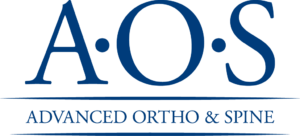
With two locations near Nashville in Mt. Juliet and Hermitage, Advanced Ortho and Spine provides patients with high-quality, personalized care while advancing orthopaedic excellence. Contact us today to learn more or to schedule your appointment.
Disclaimer: This blog provides general information and discussions about health and related subjects. The information and other content provided in this blog, or in any linked materials, are not intended and should not be construed as medical advice, nor is the information a substitute for professional medical expertise or treatment.If you or any other person has a medical concern, you should consult with your healthcare provider or seek other professional medical treatment. Never disregard professional medical advice or delay in seeking it because of something read on this blog or in any linked materials. If you think you may have a medical emergency, call your doctor or emergency services immediately.
The opinions and views expressed on this blog and website have no relation to those of any academic, hospital, health practice, or other institution.

